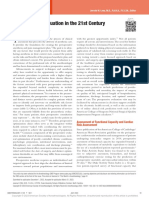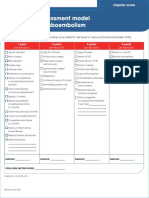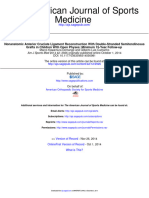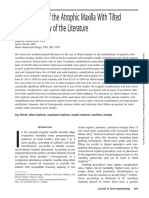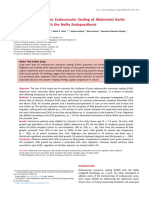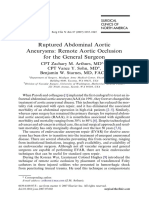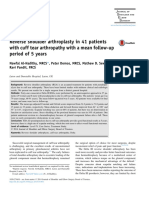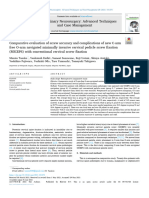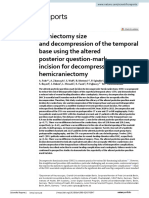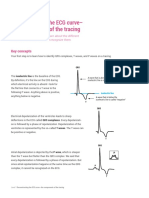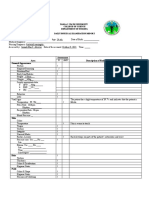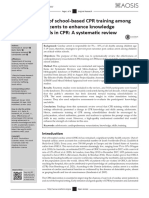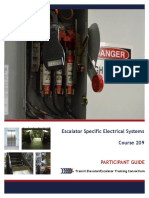Proximal Abdominal EVT Supplement
Proximal Abdominal EVT Supplement
Uploaded by
Ahmed MohammedCopyright:
Available Formats
Proximal Abdominal EVT Supplement
Proximal Abdominal EVT Supplement
Uploaded by
Ahmed MohammedOriginal Title
Copyright
Available Formats
Share this document
Did you find this document useful?
Is this content inappropriate?
Copyright:
Available Formats
Proximal Abdominal EVT Supplement
Proximal Abdominal EVT Supplement
Uploaded by
Ahmed MohammedCopyright:
Available Formats
CHOOSING THE
RIGHT DEVICE FOR THE PATIENT
Proximal Abdominal
Aortic Aneurysm Necks
The clinical issues and challenges that this anatomy poses for endovascular graft design.
BY DAVID HARTLEY, FIR; MATTHEW EAGLETON, MD; AND BLAYNE ROEDER, P h D
Endovascular aneurysm repair (EVAR) for A B
abdominal aortic aneurysms (AAAs) has
revolutionized our approach to treating
this disease. For more than a decade, this
technology has undergone intense scrutiny,
which has allowed for the rapid develop-
ment and refinement of many generations
of stent grafts—with careful attention
applied to the mechanics of deliverability,
profile, ease of use, and durability. These
assessments have not only improved our Figure 1. Three-dimensional reconstruction of a patient with
understanding of the technology, but also an infrarenal AAA with significant angulation in the neck (A).
caused the vascular community to begin to Despite the angulation, the patient had successful placement
reevaluate our understanding of the patho- of an endovascular graft that excluded the aneurysm (B).
biology of aortic diseases.
It has become clear that not only the tions in neck composition (such as the presence of
technology but also disease progression thrombus or calcification), neck angulation, and undesir-
plays an important role in the durability of endovascu- able neck length and diameter. Even as we improve the
lar aortic therapy. This is particularly important given devices and push the boundaries of what may provide a
the increasing longevity of the elderly population, even durable repair, these unfavorable features remain the key
after aortic aneurysm repair.1 One of the key features of challenges that must be overcome. Some of these fea-
EVAR that portends its success is addressing the proximal tures lead to mechanical issues that may be adequately
attachment site. In this article, we examine some of the addressed through device engineering, whereas others
clinical features that make the proximal neck of AAAs may be hallmarks of impending disease progression that
challenging to address, the evolution of EVAR device is best managed through appropriate device or patient
development that attempted to overcome these issues, selection.
and current device designs that may allow us to provide a Assessment of these issues, however, is not new, as
durable repair in the face of progressive disease. arguments for and against aggressive EVAR in unfa-
vorable anatomy have been ongoing for well over a
CLINICAL CHALLENGES WITH THE decade.2-5 Instructions for use (IFUs) for EVAR have his-
PROXIMAL AORTIC NECK torically recommended more ideal aortic necks—those
The proximal aortic neck is the crux for long-term lacking thrombus/calcification, with longer (≥ 15 mm),
EVAR durability. Endografts must achieve a seal in this parallel, nondilated walls that are relatively free of angu-
location to ensure exclusion of the aneurysm with- lation. With increased experience, however, these recom-
out developing type I endoleaks, and the device must mendations have been challenged. Outcomes of EVAR
achieve fixation to prevent migration. There are several when used in more challenging necks (Figure 1) have
morphologic features that can hinder the ability of an been inconsistent, with reports highlighting the difficul-
endograft to achieve adequate fixation and seal within ties of EVAR in hostile necks6-8 versus successful treat-
the proximal aortic neck. These features include altera- ment of patients who are well outside the IFU.9,10
4 SUPPLEMENT TO ENDOVASCULAR TODAY MAY 2014
CHOOSING THE RIGHT DEVICE FOR THE PATIENT
Thrombus and Calcification and ≤ 10 mm. The rate of type IA endoleaks was signifi-
Most IFUs recommend against EVAR in the setting of cantly greater for patients with neck lengths ≤ 10 mm
significant neck thrombus and calcification. There have (11%). At follow-up, freedom from type I endoleak was
been few direct assessments of the durability of stent 97% in those with > 15 mm necks, but only 90% in those
grafts in these settings. One difficulty in analyzing this with 11- to 15-mm necks, and 89% in those with ≤ 10-mm
morphologic feature is the lack of a universally agreed- necks. No differences were observed with respect to
upon method of quantifying the degree of calcification device migration, late conversion, aneurysm rupture,
and thrombus within the proximal neck. Bastos and col- or secondary intervention. Some of the current devices
leagues directly assessed outcomes related to the pres- have adjusted their IFUs to include treatment of short-
ence of neck thrombus and demonstrated that its pres- er-necked aneurysms.
ence (in ≥ 50% of neck circumference) was associated
with endograft migration of > 10 mm (9.3% vs 2.3%) on Neck Diameter and Dilation
univariate analysis.4 Cox multivariate analysis, however, Analysis of the EUROSTAR database by Leurs et al
identified the lack of an active fixation system as the demonstrates that 32% of patients experience neck dila-
only significant factor for device migration, although tion following EVAR, with approximately 10% of these
nearly 20% of patients with neck thrombus in this series having migration associated with dilation.17 In this analy-
experienced device migration of at least 5 mm. This may sis, risk factors for neck dilation included larger device
become a significant factor, as shorter proximal necks are main body diameter and graft oversizing by at least
thought to be permissible. 20%, whereas less frequent neck dilation was observed
Wyss et al demonstrated that the presence of neck with larger baseline neck diameters and the absence of a
thrombus may have a protective effect against the devel- suprarenal bare stent. In contrast, Cao et al reported aor-
opment of long-term complications following EVAR, tic neck dilation after EVAR was associated with neck cir-
whereas the presence of calcification, particularly when cumferential thrombus, large preoperative aortic necks,
associated with neck angulation, was associated with the and large AAA diameters.18 Post-EVAR neck dilation has
development of complications.5 However, the adverse been observed at rates as high as 63% in patients who
role of neck calcification has been disputed,11 with aneu- have thrombus-lined proximal necks.4 Neck dilation,
rysm sac regression occurring in the presence of less especially in cases of thrombus-lined or large necks, may
severe aortic neck calcification.12 be representative of underrecognized diseases and dila-
tion secondary to disease progression. This process does
Angulation not occur quickly, which may explain why problems with
Proximal neck angulation has been extensively studied stent graft fixation and sealing may not become appar-
and found to be a significant factor affecting the success ent for several years after the initial EVAR procedure.19,20
of EVAR. Grisafi et al demonstrated that the presence
of an infrarenal neck angle > 45° was associated with a Hostile Neck
significantly increased risk of initial type IA endoleak.11 Specific analysis of individual factors is difficult given that
Neck angulation can be lessened, however, with device most patients without an ideal neck have multiple morpho-
placement. After successful EVAR, the degree of both logic features that create a “hostile” neck. In a single-center
suprarenal and infrarenal neck angulation decreases, with series of 552 patients, Stather and colleagues demonstrated
the angles continuing to “straighten” for up to 3 years that the presence of hostile neck anatomy (defined as diam-
postoperatively,13 which may be independent of the type eter > 28 mm, angulation > 60°, length < 15 mm, and neck
of device used.14 flare and thrombus) was not associated with alterations in
technical success, 30-day mortality, 30-day type IA endoleak
Neck Length development, or 30-day reintervention rates.21 Outcomes
Experimental modeling of proximal fixation strength after 30 days, however, demonstrate an increased rate of
in the aortic neck demonstrates that, among a variety type I endoleaks (9.5% vs 4.5%; P = .02) in those with hostile
of graft designs, pull-out forces significantly vary, and necks, but no differences with regard to device migra-
these pull-out forces can be lowered by shortening the tion, sac expansion, aneurysm rupture, or 5-year mortality.
length of the proximal seal, likely directly related to graft Patients with hostile necks, however, required significantly
design.15 Data from the EUROSTAR registry were used to more reinterventions (23% vs 11%; P < .01), as a result of the
assess outcomes for patients with short infrarenal necks.16 need to treat type IA endoleaks.
Patients were categorized into one of three groups Binary logistic regression showed that reinterventions,
according to the neck length: > 15 mm, 11 to 15 mm, technical failure, and late type I endoleak development
MAY 2014 SUPPLEMENT TO ENDOVASCULAR TODAY 5
CHOOSING THE RIGHT DEVICE FOR THE PATIENT
were significantly increased in patients with increased
neck diameters (> 28 mm). Similar outcomes showing
early technical success have been demonstrated in other
single-center series,7 with favorable outcomes in hostile
neck anatomy being attributed to the use of suprare-
nal fixation.22 Outcomes for more recently available
stent graft systems have shown similar early outcomes
in patients with hostile neck anatomy, but long-term
assessment of their durability is not yet available.23-25
Stather et al performed a meta-analysis of EVAR in
patients with hostile necks (defined as length < 15 mm,
diameter > 28 mm, and angulation > 60°) (n = 3,039)
compared to those with a favorable neck anatomy
(n = 8,920).26 In contrast to the single-center series,
this analysis demonstrated that the presence of a hos-
tile neck was associated with an increase in 30-day mor-
tality (2.4% vs 3.5%; P < .01), intraoperative adjuncts
(8.8% vs 15.4%; P = .01), and 30-day migration (0.9% vs
1.6%; P < .01). When all three hostile neck criteria were
present, primary technical success was reduced to 94%.
Although those with a hostile neck had a significantly
increased risk for early and late type IA endoleaks and
required more secondary procedures, there were no
differences in long-term aneurysm-related mortality,
all-cause mortality, migration, or aortic expansion.
ENDOVASCULAR GRAFT DESIGN FOR
A DURABLE PROXIMAL SEAL
Overcoming the aforementioned challenges of the AAA Figure 2. Proximal design of an endovascular graft including
proximal neck has been the primary goal in endovascular a self-expanding stent with suprarenal fixation and an inter-
graft design since the first placement of an endovascular nal self-expanding stent for sealing.
graft in a human to treat AAA in 1990.27 For such a novel
treatment modality, the baseline that had to be matched Until the analysis by Liffman et al,28 originally pre-
was the known performance of the open operation, in sented in 1999, there had been little appreciation for
which a surgical graft is attached to the vessel wall with the nature of the forces being applied to the proximal
sutures. In the open operation, it was recognized that for a attachment stents. There was even less appreciation for
satisfactory seal and reliable attachment, it was necessary the extent by which the relentless pulsation forces could
to suture the proximal anastomosis to a healthy vessel. bring about fatigue failure of the metallic and fiber com-
Twenty-five years of endovascular graft design has ponents on the most proximal aspect of the endovascu-
focused on meeting this requirement, with designs lar graft, which can cause migration, with and without
evolving from devices built by the implanting physi- component failure. Some of the robust designs of this
cians for their specific patients in the operating room to early phase, enhanced by detailed improvements, have
highly engineered and extensively tested devices avail- survived to the present day and have been the platform
able today from several manufacturers. The methods of for further development of specialized devices to address
seal and attachment have varied, and include balloon- the hostile infrarenal neck.
expanded stainless steel stents (the giant Palmaz [Cordis Today, alternative infrarenal stent graft designs with
Corporation, Bridgewater, NJ]), self-expanding stents unique means of excluding the aneurysm and achieving
with infrarenal active fixation, self-expanding infrarenal proximal seal and attachment are also being conceived
stents with column strength but no active fixation, self- and evaluated in clinical trials.29,30 The surgical practice,
expanding stents with a suprarenal bare stent without in the absence of a satisfactory infrarenal neck, was to
active fixation, and steel self-expanding stents with a suture the graft to the healthy suprarenal aorta (and
bare suprarenal stent with active fixation (Figure 2). provide flow to the renal and any visceral vessels other-
6 SUPPLEMENT TO ENDOVASCULAR TODAY MAY 2014
CHOOSING THE RIGHT DEVICE FOR THE PATIENT
Figure 3. Multistage, controlled delivery of an endovascular graft is accomplished with multiple constraints. Retraction of the
delivery sheath demonstrates proximal constraints (bare stent inside cap) (A) and a distal constraining wire (B).
wise occluded) by implantation or bypass procedures. ment accuracy of the endovascular graft system has a
As such, the alternative endovascular strategy is also to significant effect on the success of the repair, specifically
move more proximal into the visceral aorta for better the ability to attain adequate proximal seal. Consider
seal and attachment in healthy vessels. Again mimick- the AAA with a 15-mm-long proximal neck. If deploy-
ing the surgical approach, endovascular devices were ment accuracy can only be expected to be within 5 mm,
developed, beginning as early as 1997, with the intent to the resulting seal zone may only be 10 mm in length, or
place the sealing component above the renal arteries and worse yet, a renal artery may be covered.
supply flow to the renal and the mesenteric vessels with Deployment accuracy is most critical when the neck
fenestrations and/or side branches.31 Continued develop- available for seal is complicated with a short length,
ment of devices targeted toward a more proximal seal angulation, calcification, and/or thrombus. Multistaged,
continues today.32-34 controlled delivery facilitates accurate placement of the
Similar to open repair, the primary design objective endograft,36,37 which in turn can maximize the amount
of AAA endovascular grafts is simply to prevent aneu- of healthy aorta available for seal (Figure 3). However, it
rysm rupture and subsequent patient death. However, is important to note that specific aortic features (eg, a
durable exclusion of the aneurysm sac from hemody- short neck, angulation, calcification, and/or thrombus)
namic pressure requires that several interrelated design that require a precise landing zone may also make accu-
functions and specific performance goals be achieved rate endograft placement more difficult and result in an
to meet this primary design objective. First, the endo- increased number of procedural complications.38
vascular graft delivery system must have the ability to
accurately deploy the graft in its intended location. Radial Force and Proximal Seal
Once placed in its intended landing site, the endovas- Once placed in a stable position, the endovascular
cular graft must provide a proximal seal and prevent graft must inhibit blood from leaking around the proxi-
its migration. Most importantly, the graft must provide mal seal (type IA endoleaks). Stents at the proximal
these functions for the life of the patient; structural end of the graft must exert adequate radial force, or
durability of the device is paramount. Herein is a dis- sealing pressure, to keep the graft against the aortic
cussion of these fundamental design features and the wall throughout the cardiac cycle and potentially other
performance criteria required to achieve these design biomechanical motions to prevent type I endoleaks.
functions. The radial force produced by stents varies based on the
extent of oversizing, and thus proper oversizing is criti-
Deployment Accuracy cal in maintaining a seal in the short- and long-term.
Achieving reliable and accurate deployment is criti- Endovascular grafts are designed and tested to maintain
cal to the long-term success of the repair. Failure of the adequate radial pressure over a specified range of over-
endovascular graft to deploy and subsequent need for sizing. These oversizing recommendations are explicitly
conversion to open repair puts the patient at high risk. defined in the IFU, and oversizing outside these bounds
Buth et al reported a perioperative mortality rate of risks complications such as endoleaks,39 continued
22% for patients who were converted to open repair aneurysm growth and/or migration,40 or endovascular
in the EUROSTAR study.35 Although the majority of graft collapse.41
the deployment failures in this study were related to The mechanical properties and long-term stability of
early device designs, they underscore the importance of the aorta in the seal zone must also be considered in
deployment reliability. In addition to reliability, deploy- selecting an appropriate seal, so that the proximal endo-
MAY 2014 SUPPLEMENT TO ENDOVASCULAR TODAY 7
CHOOSING THE RIGHT DEVICE FOR THE PATIENT
A B
Figure 5. Test setup used to evaluate fatigue durability of a
bifurcated endovascular graft to treat AAAs. Devices sit inside
the bifurcated tubes as the tubes are subjected to physiologic
motion. Laser measurement tools are used to measure the
motion of the tubes.
Migration Resistance
In order to maintain a durable seal and exclude the
aneurysm for the life of the patient, the endovascular
graft must maintain its position relative to the aorta.
Figure 4. An endovascular graft incorporating fenestrations Endograft migration can lead to late failure of the repair,
and scallops to accommodate visceral vessels and allow seal- specifically, type I endoleak, aneurysm rupture, and
ing in the suprarenal aorta (A). Alternative designs incorpo- death. Endovascular grafts are subject to a hemodynami-
rate features such as pivoting fenestrations to allow for vari- cally challenging environment in which they must resist
ability in visceral vessel location (B). the physiologic forces associated with blood flow. Fluid
mechanics analyses show that bifurcated aortic endovas-
vascular graft design can take advantage of that sealing cular grafts are subject to cyclic forces on the order of 10 N,
zone. As previously stated, short-length seal zones, large acting to displace the graft in a caudal direction for the
neck diameters, significant angulation, the presence of life of the patient.28 As previously described, many means
thrombus, and calcification may increase the risks for of fixation have been utilized in commercially available
type I endoleaks and sac expansion. These increased risks endovascular grafts, including columnar strength, iliac fix-
may not be a result of limitations in endograft design, ation, bare stents, and active fixation (eg, hooks or barbs)
but rather limitations in the durability of aortic seal zones (Figure 2). Nonclinical studies comparing grafts with and
with these features. without active fixation have demonstrated that endo-
Architects and civil engineers have understood for vascular grafts with active fixation have higher migration
thousands of years that there are specific requirements resistance (ie, force required to displace them from the
for designing foundations so that a structure is stable aorta) than those without active fixation.42-44 These find-
and durable for centuries to come. These requirements ings have been supported by lower migration rates of
have less to do with the structural design capabilities of devices with active suprarenal fixation in clinical use.40,45-48
concrete, steel, or wood, but the ability of the earth to
be stable under the weight of a building. We are only just Fatigue Durability
beginning to understand these tradeoffs for endovascu- Finally, the endovascular graft must be durable in
lar grafts, especially in terms of how the seal zone of an order to maintain its function for the life of the patient.
endovascular graft interacts with a hostile neck. Rather Endovascular grafts must be evaluated in all modes where
than pushing the limits of infrarenal EVAR into a less- cyclic (fatigue) loads are expected. Primary cyclic loads are
than-adequate seal zone, branched and fenestrated endo- a result of pulsatile blood flow. However, the mechani-
vascular grafts were developed to take advantage of the cal loads and arterial motions from other sources, such
additional suprarenal aortic segment, effectively increas- as respiration or other bodily motions, also need to be
ing the amount of sealing zone available (Figure 4).31 considered. The aggregate effects of these loads on all
8 SUPPLEMENT TO ENDOVASCULAR TODAY MAY 2014
CHOOSING THE RIGHT DEVICE FOR THE PATIENT
components of the endovascular graft (eg, stents, graft, conditions for endovascular aortic aneurysm repair. J Vasc Surg. 2011;54:300-306.
10. Fairman RM, Velazquez OC, Carpenter JP, et al. Midterm pivotal trial results of the Talent low profile system for repair of
sutures, etc.) need to be thoroughly evaluated. Clinical abdominal aortic aneurysm: analysis of complicated versus uncomplicated aortic necks. J Vasc Surg. 2004;40:1074-1082.
use of early endovascular grafts has elucidated many 11. Grisafi JL, Rahbar R, Nelms J, et al. Challenging neck anatomy is associated with need for intraoperative endovascular
adjuncts during endovascular aortic aneurysm repair (EVAR). Ann Vasc Surg. 2011;25:729-734.
potential failure modes. These failures provided the 12. Kaladji A, Cardon A, Abouliatim I, et al. Preoperative predictive factors of aneurysmal regression using the reporting
standards for endovascular aortic aneurysm repair. J Vasc Surg. 2012;55:1287-1295.
opportunity to develop new graft designs and, in parallel, 13. van Keulen JW, Moll FL, Arts J, et al. Aortic neck angulations decrease during and after endovascular aneurysm repair. J
new test methods to evaluate for potential failure modes. Endovasc Ther. 2010;17:594-598.
14. Hoshina K, Akai T, Takayama T, et al. Outcomes and morphologic changes after endovascular repair for abdominal aortic
The result is mature testing equipment (Figure 5) and aneurysms with severely angulated neck: a device specific analysis. Circ J. 2013;77:1996-2002.
standards for endovascular testing.49 Standards typically 15. Bosman WM, Steenhoven TJ, Suarez DR, et al. The proximal fixation strength of modern EVAR grafts in a short aneurysm
neck. An in vitro study. Eur J Vasc Endovasc Surg. 2010;39:187-192.
require testing to be completed for a 10-year equivalent 16. Leurs LJ, Kievit J, Dagnelie PC, et al. Influence of infrarenal neck length on outcome of endovascular abdominal aortic
of 400 million cycles. aneurysm repair. J Endovasc Ther. 2006;13:640-648.
17. Leurs LJ, Stultiens G, Kievit J, et al. Adverse events at the aneurysmal neck identified at follow-up after endovascular
abdominal aortic aneurysm repair: how do they correlate? Vascular. 2005;13:261-267.
SUMMARY 18. Cao P, Verzini F, Parlani G, et al. Predictive factors and clinical consequences of proximal aortic neck dilatation in 230
patients undergoing abdominal aorta aneurysm repair with self-expandable stent-grafts. J Vasc Surg. 2003;37:1200-1205.
The key challenges in achieving a stable and durable 19. Verhoeven BA, Waasdorp EJ, Gorrepati ML, et al. Long-term results of Talent endografts for endovascular abdominal
proximal seal in EVAR include inadequate length of aortic aneurysm repair. J Vasc Surg. 2011;53:293-298.
20. Espinosa G, Ribeiro Alves M, Ferreira Caramalho M, et al. A 10-year single-center prospective study of endovascular
healthy aorta for sealing, large neck diameters, and the abdominal aortic aneurysm repair with the talent stent-graft. J Endovasc Ther. 2009;16:125-135.
presence of thrombus or calcification. These challenges 21. Stather PW, Sayers RD, Cheah A, et al. Outcomes of endovascular aneurysm repair in patients with hostile neck
anatomy. Eur J Vasc Endovasc Surg. 2012;44:556-561.
have become increasingly critical as EVAR is dissemi- 22. Lee JT, Ullery BW, Zarins CK, et al. EVAR deployment in anatomically challenging necks outside the IFU. Eur J Vasc
nated to more patients, especially those whose proximal Endovasc Surg. 2013;46:65-73.
23. Bachoo P, Verhoeven ELG, Larzon T. Early outcome of endovascular aneurysm repair in challenging aortic neck morphol-
neck anatomy challenges IFU recommendations. These ogy based on experience from the GREAT C3 registry. J Cardiovasc Surg. 2013;54:573-580.
complex anatomies present key challenges to endovas- 24. Smeds MR, Jacobs DL, Peterson GJ, Peterson BG. Short-term outcomes of the C3 excluder for patients with abdominal
aortic aneurysms and unfavorable proximal aortic seal zones. Ann Vasc Surg. 2013;27:8-15.
cular graft design. Engineering requirements for device 25. Mwipatayi BP, Picardo A, Wong J, et al. Endovascular repair of abdominal aortic aneurysms with reverse taper neck
deployment, proximal sealing, migration resistance, and anatomy using the Endurant stent-graft: analysis of stent-graft oversizing. J Endovasc Ther. 2013;20:514-522.
26. Stather PW, Wild JB, Sayers RD, et al. Endovascular aortic aneurysm repair in patients with hostile neck anatomy. J
durability were reviewed relative to these key challenges. Endovasc Ther. 2013;20:623-637.
Although advancements in endovascular graft design 27. Parodi JC, Palmaz JC, Barone HD. Transfemoral intraluminal graft implantation for abdominal aortic aneurysms. Ann
Vasc Surg. 1991;5:491-499.
continue to push the indications for EVAR, it remains 28. Liffman K, Lawrence-Brown MM, Semmens JB, et al. Analytical modeling and numerical simulation of forces in an
endoluminal graft. J Endovasc Ther. 2001;8:358-371.
clear that healthy aorta is required for adequate fixation 29. Karthikesalingam A, Cobb RJ, Khoury A, et al. The morphological applicability of a novel Endovascular Aneurysm Sealing
of the endograft to prevent migration and to maintain a (EVAS) System (Nellix) in patients with abdominal aortic aneurysms. Eur J Vasc Endovasc Surg. 2013;46:440-445.
30. Mehta M, Valdés FE, Nolte T et al. One-year outcomes from an international study of the Ovation abdominal stent graft
durable seal without endoleaks. n system for endovascular aneurysm repair. J Vasc Surg. 2014;59:65-73.
31. Park JH, Chung JW, Choo IW, et al. Fenestrated stent-grafts for preserving visceral arterial branches in the treatment of
abdominal aortic aneurysms: preliminary experience. J Vasc Interv Radiol. 1996;7:819-823.
David Hartley, FIR, is a Fellow of the (Australian) 32. Greenberg RK, Sternbergh WC, Makaroun M, et al. Intermediate results of a United States multicenter trial of fenestrated
Institute of Radiography and a consultant to Cook Medical endograft repair for juxtarenal abdominal aortic aneurysms. J Vasc Surg. 2009;50:730-737.
33. Quiñones-Baldrich WJ, Holden A, Mertens R, et al. Prospective, multicenter experience with the Ventana fenestrated
in Perth, Western Australia. system for juxtarenal and pararenal aortic aneurysm endovascular repair. J Vasc Surg. 2013;58:1-9.
Matthew Eagleton, MD, is with the Department of 34. Kitagawa A, Greenberg RK, Eagleton MJ, Mastracci TM. Zenith p-Branch standard fenestrated endovascular graft for
juxtarenal abdominal aortic aneurysms. J Vasc Surg. 2013;58:291-300.
Vascular Surgery at the Cleveland Clinic in Cleveland, 35. Buth J, Laheij RJF; on behalf of the EUROSTAR Collaborators. Early complications and endoleaks after endovascular
Ohio. He disclosed that he has relevant financial interests abdominal aortic aneurysm repair: report of a multicenter study. J Vasc Surg. 2000;31:134-146.
36. Chuter TA. The choice of stent-graft for endovascular repair of abdominal aortic aneurysm. J Cardiovasc Surg.
related to Cook Medical and Bolton Medical. Dr. Eagleton 2003;44:519-525.
may be reached at (216) 445-1167; eagletm@ccf.org. 37. Brunkwall J. How to design the optimal stent graft—what have we learnt? Scand J Surg. 2008;97:191-194.
38. Hovsepian DM, Hein AN, Pilgram TK, et al. Endovascular abdominal aortic aneurysm repair in 144 patients: correlation of
Blayne Roeder, PhD, is Director of Product Development, aneurysm size, proximal aortic neck length, and procedure-related complications. J Vasc Interv Radiol. 2001;12:1373-1382.
Aortic Intervention at Cook Medical in Bloomington, Indiana. 39. Mohan IV, Laheij RJ, Harris PL; on behalf of the EUROSTAR Collaborators. Risk factors for endoleak and the evidence for
stent-graft oversizing in patients undergoing endovascular aneurysm repair. Eur J Vasc Endovasc Surg. 2001;21:344-349.
40. Sternbergh WC, Money SR, Greenberg RK, et al; for the Zenith Investigators. Influence of endograft oversizing on device migra-
1. Mani K, Bjorck M, Lundkvist J, Wanhainen A. Improved long-term survival after abdominal aortic aneurysm repair. tion, endoleak, aneurysm shrinkage, and aortic neck dilation: results from the Zenith multicenter trial. J Vasc Surg 2004;39:20-26.
Circulation. 2009;120:201-211. 41. Idu MM, Reekers JA, Balm R, et al. Collapse of a stent-graft following treatment of a traumatic thoracic aortic rupture. J
2. Albertini JN, Kalliafas S, Travis S, et al. Anatomical risk factors for proximal perigraft endoleak and graft migration follow- Endovasc Ther. 2005;12:503-507.
ing endovascular repair of abdominal aortic aneurysms. Eur J Endovasc Surg. 2000;19:308-312. 42. Veerapen R, Dorandeu A, Serre I, et al. Improvement in proximal aortic endograft fixation: an experimental study using
3. Gitlitz DB, Ramaswami G, Kaplan D, et al. Endovascular stent grafting in the presence of aortic neck filling defects: Early different stent-grafts in human cadaveric aortas. J Endovasc Ther. 2003;10:1101-1109.
clinical experience. J Vasc Surg. 2001;33:340-344. 43. Resch T, Malina M, Lindblad B, et al. The impact of stent design on proximal stent-graft fixation in the abdominal aorta:
4. Bastos Goncalves F, Verhagen HJ, Chinsakchai K, et al. The influence of neck thrombus on clinical outcome and aneurysm an experimental study. Eur J Vasc Endovasc Surg. 2000;20:190-195.
morphology after endovascular aneurysm repair. J Vasc Surg. 2012;56:36-44. 44. Malina M, Lindblad B, Ivancev K, et al. Endovascular AAA exclusion: will stents with hooks and barbs prevent stent-graft
5. Wyss TR, Dick F, Brown LC, Greenhalgh RM. The influence of thrombus, calcification, angulation, and tortuosity of migration? J Endovasc Surg. 1998;5:310-317.
attachment sites on the time to the first graft-related complication after endovascular aneurysm repair. J Vasc Surg. 45. Zarins CK, Bloch DA, Crabtree T, et al. Stent graft migration after endovascular aneurysm repair: importance of proximal
2011;54:965-971. fixation. J Vasc Surg. 2003;38:1264-1272.
6. Sternbergh WC 3rd, Carter G, York JW, et al. Aortic neck angulation predicts adverse outcome with endovascular 46. Tonnessen BH, Sternbergh WC, Money SR. Mid- and long-term device migration after endovascular abdominal aortic
abdominal aortic aneurysm repair. J Vasc Surg. 2002;35:482-486. aneurysm repair: a comparison of AneuRX and Zenith endografts. J Vasc Surg. 2005;42:392-401.
7. Aburahma AF, Campbell JE, Mousa AY, et al. Clinical outcomes for hostile versus favorable aortic neck anatomy in 47. Abbruzzese TA, Kwolek CJ, Brewster DC, et al. Outcomes following endovascular abdominal aortic aneurysm repair (EVAR):
endovascular aortic aneurysm repair using modular devices. J Vasc Surg. 2011;54:13-21. an anatomic and device-specific analysis. J Vasc Surg. 2008;48:19-28.
8. Fulton JJ, Farber MA, Sanchez LA, et al. Effect of challenging neck anatomy on mid-term migration rates in AneuRx 48. Greenberg RK, Chuter TA, Cambria RP, et al. Zenith abdominal aortic aneurysm endovascular graft. J Vasc Surg. 2008;48:1-9.
endografts. J Vasc Surg. 2006;44:932-937; discussion 937. 49. ANSI/AAMI/ISO 25539-1:2003/(R)2009 Cardiovascular implants— Endovascular devices— Part 1: Endovascular
9. Torsello G, Troisi N, Donas KP, Austermann M. Evaluation of the Endurant stent graft under instructions for use vs off-label prostheses.
MAY 2014 SUPPLEMENT TO ENDOVASCULAR TODAY 9
You might also like
- Preoperative Evaluation in The 21st CenturyDocument13 pagesPreoperative Evaluation in The 21st CenturyPaulHerrera0% (1)
- Sleep Study Test: PSG Summary ReportDocument12 pagesSleep Study Test: PSG Summary Reportkuwar palNo ratings yet
- VTE Risk Assessment Tool Caprini Score Card Eng 30apr2018Document2 pagesVTE Risk Assessment Tool Caprini Score Card Eng 30apr2018Ahmed MohammedNo ratings yet
- Cervical Total Disc Replacement: Long-Term OutcomesDocument12 pagesCervical Total Disc Replacement: Long-Term OutcomesKyle RobinNo ratings yet
- UC201708097IE Heli-FX Sell Sheet White Paper DrFoteh GlobalDocument9 pagesUC201708097IE Heli-FX Sell Sheet White Paper DrFoteh Globalliu derekNo ratings yet
- Tips and Techniques For Optimal Stent Graft Placement in Angulated Aneurysm NecksDocument6 pagesTips and Techniques For Optimal Stent Graft Placement in Angulated Aneurysm NecksAhmed MohammedNo ratings yet
- Στέλιος Κούτσιας, Md, Phd Λέκτορας Αγγειοχειρουργικής - Ενδοαγγειακής Χειρουργικής Ιατρικη Σχολη Θεσσαλιασ Π.Γ.Ν.ΛαρισασDocument64 pagesΣτέλιος Κούτσιας, Md, Phd Λέκτορας Αγγειοχειρουργικής - Ενδοαγγειακής Χειρουργικής Ιατρικη Σχολη Θεσσαλιασ Π.Γ.Ν.Λαρισασmahmoud fuqahaNo ratings yet
- Complicaciones Despues Del Tratamiento Quirúrgico en FX Humero ProximalDocument11 pagesComplicaciones Despues Del Tratamiento Quirúrgico en FX Humero ProximalNinhoTonyOfficialNo ratings yet
- Conf 3Document10 pagesConf 3haminatrafNo ratings yet
- Endografts For The Treatment of Abdominal Aortic ADocument15 pagesEndografts For The Treatment of Abdominal Aortic AAhmed MohammedNo ratings yet
- #x2018 Short Bars Crossed’ To Remodel TheDocument6 pages#x2018 Short Bars Crossed’ To Remodel Thesensation sex shopNo ratings yet
- Managementof Postoperative Complicationsfollowing Endovascularaorticaneurysm RepairDocument14 pagesManagementof Postoperative Complicationsfollowing Endovascularaorticaneurysm Repairvictor ibarra romeroNo ratings yet
- Embrasure Wire Tracy and GuttaDocument6 pagesEmbrasure Wire Tracy and Gutta6hd6mnrzw2No ratings yet
- Aaa Directional Tip ControlDocument6 pagesAaa Directional Tip ControlClaudio GotoNo ratings yet
- Definingnoptimal Calcar Screw Positioning in Proximal Humerus Fracture FixationDocument7 pagesDefiningnoptimal Calcar Screw Positioning in Proximal Humerus Fracture FixationAJ CésarNo ratings yet
- Medicine The American Journal of SportsDocument8 pagesMedicine The American Journal of Sportshieuminhduong7No ratings yet
- Aaid Joi D 11 00068Document8 pagesAaid Joi D 11 00068Hema SinghNo ratings yet
- Aneurysm Growth After Endovascular Sealing of AbdoDocument6 pagesAneurysm Growth After Endovascular Sealing of AbdoibarbomanNo ratings yet
- EVAR SpecsDocument23 pagesEVAR SpecsJanineNo ratings yet
- JCM 12 00302 v2Document4 pagesJCM 12 00302 v2noyossmo3udo10ivNo ratings yet
- Endovascular Today June 2016Document24 pagesEndovascular Today June 2016liu derekNo ratings yet
- Aaa RotoDocument11 pagesAaa RotoKarely TapiaNo ratings yet
- Placa Bloqueada Olecrarnon Adulto MayorDocument7 pagesPlaca Bloqueada Olecrarnon Adulto Mayorlriveros540No ratings yet
- Review Paper: Contemporarymanagementof Femoralneck Fractures: The Young and The OldDocument31 pagesReview Paper: Contemporarymanagementof Femoralneck Fractures: The Young and The OldADITYA REZA PRIANUGRAHANo ratings yet
- Chimeric Groin Free Flaps Design and Clinical Application - Microsurgery, Vol. 36 Issue 3 (BZ 22588160)Document10 pagesChimeric Groin Free Flaps Design and Clinical Application - Microsurgery, Vol. 36 Issue 3 (BZ 22588160)Manny TrujilloNo ratings yet
- Device Closure in Multiple Atrial Septal Defect Secundum Concomitant With Atrial FlutterDocument10 pagesDevice Closure in Multiple Atrial Septal Defect Secundum Concomitant With Atrial FlutterInternational Journal of Innovative Science and Research TechnologyNo ratings yet
- 00011Document10 pages00011M Joaquin Robles OrtizNo ratings yet
- 1400-Texto Del Artículo-30854-1-10-20220413Document9 pages1400-Texto Del Artículo-30854-1-10-20220413Celso Alfonso PeñaNo ratings yet
- 2019 - 12 - Τhe AFX Unibody Bifurcated Unibody Aortic Endograft for the Treatment of Abdominal Aortic Aneurysms Current Evidence and Future PerspectivesDocument38 pages2019 - 12 - Τhe AFX Unibody Bifurcated Unibody Aortic Endograft for the Treatment of Abdominal Aortic Aneurysms Current Evidence and Future PerspectivesRiccardo ConcuNo ratings yet
- Seguimiento A 5 Años PTGH ReversaDocument7 pagesSeguimiento A 5 Años PTGH Reversamarcelogascon.oNo ratings yet
- Comparison Between On Lay and in Lay Mesh in Repair of Incisional HerniaDocument15 pagesComparison Between On Lay and in Lay Mesh in Repair of Incisional HerniaAshok kumarNo ratings yet
- The Management of Severe Aortoiliac Occlusive Disease: Endovascular Therapy Rivals Open ReconstructionDocument10 pagesThe Management of Severe Aortoiliac Occlusive Disease: Endovascular Therapy Rivals Open ReconstructionRobert ChristevenNo ratings yet
- Bishara 1987Document12 pagesBishara 1987LanaNo ratings yet
- The Jenavalve Pericardial Transcatheter Aortic Valve Replacement System To Treat Aortic Valve DiseaseDocument15 pagesThe Jenavalve Pericardial Transcatheter Aortic Valve Replacement System To Treat Aortic Valve Diseasejiaxuanliu988No ratings yet
- Centelles Et Al 2016Document8 pagesCentelles Et Al 2016henriquetaranNo ratings yet
- Transaortic Valve ReplacementDocument11 pagesTransaortic Valve ReplacementManuela CulicaNo ratings yet
- Chest Wall Stabilization in Trauma Patients: Why, When, and How?Document12 pagesChest Wall Stabilization in Trauma Patients: Why, When, and How?Ariane YudhiantiNo ratings yet
- Mandibular Surgery Technologic and Technical Improvements - 2014 - Oral and Maxillofacial Surgery Clinics of North AmericaDocument35 pagesMandibular Surgery Technologic and Technical Improvements - 2014 - Oral and Maxillofacial Surgery Clinics of North AmericaGabriela Lizbeth ArmentaNo ratings yet
- s13018 018 0814 1Document9 pagess13018 018 0814 1Someshwar GuptNo ratings yet
- 2004-AJODO-Joondeph-Open-bite Closure With Mandibular OsteotomyDocument3 pages2004-AJODO-Joondeph-Open-bite Closure With Mandibular OsteotomyAlejandro RuizNo ratings yet
- Anterior Vertebral Body Tethering For Adolescent Idiopathic ScoliosisDocument11 pagesAnterior Vertebral Body Tethering For Adolescent Idiopathic ScoliosisΕιρήνη ΒασιλάκηNo ratings yet
- Closed Reduction and Percutaneous Kirschner Wire Fixation of Displaced Colles Fracture in AdultsDocument7 pagesClosed Reduction and Percutaneous Kirschner Wire Fixation of Displaced Colles Fracture in AdultsnaluphmickeyNo ratings yet
- Park2013 - RetroauriDocument8 pagesPark2013 - RetroaurianviNo ratings yet
- Comparative Evaluation of Screw Accuracy and Complications of - 2021 - InterdiscDocument6 pagesComparative Evaluation of Screw Accuracy and Complications of - 2021 - Interdiscbruno mañonNo ratings yet
- Craniectomy Size and Decompression of The Temporal Base Using The Altered Posterior Question Mark Incision For Decompressive HemicraniectomyDocument9 pagesCraniectomy Size and Decompression of The Temporal Base Using The Altered Posterior Question Mark Incision For Decompressive HemicraniectomyVigneshNo ratings yet
- Countersinking The Lag Screw or Blade During.17Document8 pagesCountersinking The Lag Screw or Blade During.17Neung ThadaNo ratings yet
- Wolff 2019Document7 pagesWolff 2019Christopher BermeoNo ratings yet
- Augmentation Plating Leaving The Nail in Situ Is An Excellent Option For Treating Femoral Shaft Nonunion After IM Nailing: A Multicentre StudyDocument7 pagesAugmentation Plating Leaving The Nail in Situ Is An Excellent Option For Treating Femoral Shaft Nonunion After IM Nailing: A Multicentre StudytomimacagnoNo ratings yet
- Stacey 2016Document9 pagesStacey 2016Hamoud AlhaidariNo ratings yet
- Tinggal Di Google TranslateDocument16 pagesTinggal Di Google TranslateElisha RosalynNo ratings yet
- DHS Screw Position JEDocument8 pagesDHS Screw Position JEDan IonescuNo ratings yet
- Outcomes of Immediate Vertical Rectus AbDocument10 pagesOutcomes of Immediate Vertical Rectus Abberita tidakjelasNo ratings yet
- Surgically Assisted Rapid Palatal Expansion:: An Outpatient Technique With Long-Term StabilityDocument4 pagesSurgically Assisted Rapid Palatal Expansion:: An Outpatient Technique With Long-Term StabilityemanNo ratings yet
- Percutaneaus Kirschner-Wire Fixation For Displaced Distal Forearm Fractures in ChildrenDocument5 pagesPercutaneaus Kirschner-Wire Fixation For Displaced Distal Forearm Fractures in ChildrennaluphmickeyNo ratings yet
- Wilson Paper-1Document10 pagesWilson Paper-1MehNo ratings yet
- Aziz 2009Document5 pagesAziz 2009Victor VitoloNo ratings yet
- TevarDocument9 pagesTevarpriyavajpayee21No ratings yet
- 267 English 1Document8 pages267 English 1Abante_gammaNo ratings yet
- A R A A C L S B C I C B G: Lveolar Idge Ugmentation: Omparative Ongitudinal Tudy Etween Alvaria and Liac Rest ONE RaftsDocument7 pagesA R A A C L S B C I C B G: Lveolar Idge Ugmentation: Omparative Ongitudinal Tudy Etween Alvaria and Liac Rest ONE RaftsDr. Jalisson VicenteNo ratings yet
- Becker 2014Document5 pagesBecker 2014hans mendezNo ratings yet
- Stent Graft Induced Aortic Wall Injury— AnesDocument4 pagesStent Graft Induced Aortic Wall Injury— AnesJamie ElmawiehNo ratings yet
- IVUS (IntraVascular UltraSound) Image Guidance for Treatment of Aorto-Iliac PathologiesFrom EverandIVUS (IntraVascular UltraSound) Image Guidance for Treatment of Aorto-Iliac PathologiesNo ratings yet
- Endovascular Abdominal Aortic Repair- Endoleak Treatment: A Case-based ApproachFrom EverandEndovascular Abdominal Aortic Repair- Endoleak Treatment: A Case-based ApproachNo ratings yet
- Ecr 12 1 40Document6 pagesEcr 12 1 40Ahmed MohammedNo ratings yet
- Endografts For The Treatment of Abdominal Aortic ADocument15 pagesEndografts For The Treatment of Abdominal Aortic AAhmed MohammedNo ratings yet
- Cathetersandwires DrVaibhavDocument15 pagesCathetersandwires DrVaibhavAhmed MohammedNo ratings yet
- Doacs For VteDocument10 pagesDoacs For VteAhmed MohammedNo ratings yet
- Direct Oral Anticoagulants (DOACs)Document17 pagesDirect Oral Anticoagulants (DOACs)Ahmed MohammedNo ratings yet
- 5hodgikiss NewInnovationsinEndoleakManagementRead OnlyDocument6 pages5hodgikiss NewInnovationsinEndoleakManagementRead OnlyAhmed MohammedNo ratings yet
- DOAC VTE Treatment April2020Document4 pagesDOAC VTE Treatment April2020Ahmed MohammedNo ratings yet
- Long-Term Follow-Up of Type II Endoleak Embolization Reveals The Need For Close SurveillanceDocument8 pagesLong-Term Follow-Up of Type II Endoleak Embolization Reveals The Need For Close SurveillanceAhmed MohammedNo ratings yet
- Thromboprohylaxis and DVT in Surgical PRDocument7 pagesThromboprohylaxis and DVT in Surgical PRAhmed MohammedNo ratings yet
- FR System - Vs Guage SystemDocument12 pagesFR System - Vs Guage SystemAhmed MohammedNo ratings yet
- Fdar FormDocument3 pagesFdar Formtwinks cabadingNo ratings yet
- Pathology of CardiovascularDocument40 pagesPathology of CardiovascularJulie Mae Asuncion RigosNo ratings yet
- Acls DrugsDocument7 pagesAcls DrugsMarione Thea RodriguezNo ratings yet
- HSG TA 7 de 1Document8 pagesHSG TA 7 de 1Anh MinhNo ratings yet
- 10/16/20 Phonocardiography 1 10/16/20 1Document56 pages10/16/20 Phonocardiography 1 10/16/20 1Jothibasu MarappanNo ratings yet
- Yellow Belt Level 01 - Fact SheetDocument2 pagesYellow Belt Level 01 - Fact SheetJo Marie LeeNo ratings yet
- Lecture 1 BLS Introduction To Chain of SurvivalDocument23 pagesLecture 1 BLS Introduction To Chain of Survivaldonibung 007No ratings yet
- 21 Surgical Management of A Congenital ArteriovenousDocument3 pages21 Surgical Management of A Congenital ArteriovenousJimenez-Espinosa JeffersonNo ratings yet
- Coagularea Intravasculara DiseminataDocument4 pagesCoagularea Intravasculara DiseminataLaurentiu Covrescu100% (1)
- Primary Angioplasty - Mechanical Interventions For Acute Myocardial Infarction-CRC Press (2009)Document260 pagesPrimary Angioplasty - Mechanical Interventions For Acute Myocardial Infarction-CRC Press (2009)afianti sulastriNo ratings yet
- Ch013 001-007 HypertensionDocument7 pagesCh013 001-007 Hypertensiond_94100% (5)
- Area Assessment Description of Findings & Interpretation General Appearance PostureDocument7 pagesArea Assessment Description of Findings & Interpretation General Appearance PostureMica OmotsosircNo ratings yet
- Effectiveness of School-Based CPR Training Among Adolescents To Enhance Knowledge and Skills in CPR: A Systematic ReviewDocument9 pagesEffectiveness of School-Based CPR Training Among Adolescents To Enhance Knowledge and Skills in CPR: A Systematic Reviewputu juniNo ratings yet
- Vital Sign: Blood Pressure and Its AlterationsDocument55 pagesVital Sign: Blood Pressure and Its Alterationsbemina jaNo ratings yet
- General Population (No Diabetes or CKD) Diabetes or CKD PresentDocument9 pagesGeneral Population (No Diabetes or CKD) Diabetes or CKD PresentSteven Junius Chandra100% (2)
- PDA Case StudyDocument5 pagesPDA Case StudyDiana Andrea AyongaoNo ratings yet
- Journal ReadingDocument53 pagesJournal ReadingRhadezahara PatrisaNo ratings yet
- 209 Coursebook With Cover PDFDocument135 pages209 Coursebook With Cover PDFSandar ZweNo ratings yet
- Case Presentation On CHFDocument13 pagesCase Presentation On CHFCalingalan Hussin CaluangNo ratings yet
- ESSAYDocument2 pagesESSAYBokNo ratings yet
- Adobe Scan 21 Oct 2021Document1 pageAdobe Scan 21 Oct 2021Sunil RahangdaleNo ratings yet
- Sample Patient ProfileDocument7 pagesSample Patient ProfileElisabeth CampbellNo ratings yet
- Stroke Knowledge and Awareness: An Integrative Review of The EvidenceDocument12 pagesStroke Knowledge and Awareness: An Integrative Review of The EvidenceMargareta NaguNo ratings yet
- Calcium Channel BlockersDocument3 pagesCalcium Channel BlockersrajeshmangalNo ratings yet
- P.01D Foundations of Neonatal Resuscitation Part 5Document3 pagesP.01D Foundations of Neonatal Resuscitation Part 5Yndhira Xheyenn Laylo100% (1)
- Huszar's Basic Dysrhythmias and Acute Coronary Syndromes: Interpretation & Management. 4th Edition. ISBN 0323081681, 978-0323081689Document23 pagesHuszar's Basic Dysrhythmias and Acute Coronary Syndromes: Interpretation & Management. 4th Edition. ISBN 0323081681, 978-0323081689lindingwm100% (15)
- Standard Monitors in AnaesthesiaDocument70 pagesStandard Monitors in AnaesthesiaAFOLAYAN OLUWAJUWON PRAISENo ratings yet
- Blood WitchDocument1 pageBlood Witchyami edwardNo ratings yet
